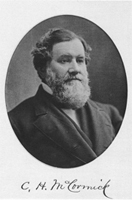About the Center
The mission of the Shenandoah Valley Agricultural Research and Extension Center is to provide agricultural producers and Extension educators in Virginia and the mid-Atlantic region with applied, research-based information on the soil, animal, and plant components of forage-based livestock systems. We also strive to preserve the historic "McCormick Farm"-- site of the invention of the McCormick grain reaper that started the mechanical revolution in agriculture. It is also our goal to open the center to adults and youth for educational opportunities on McCormick history as well as sustainable agricultural, environmental and wildlife practices.

History of the AREC
The Shenandoah Valley Research Station was officially opened in 1956 as a branch of the Virginia Agricultural Experiment Station of Virginia Tech. The 620-acre farm, known historically as “Walnut Grove Farm,” is the ancestral home of Robert McCormick and his son, Cyrus Hall McCormick. Born on this farm in 1809, Cyrus Hall McCormick is famous for building the first practical grain reaper, which was successfully demonstrated in a field of oats owned by John Steele in nearby Steeles Tavern in 1831. Patented in 1834, the reaper is credited for starting the mechanical revolution in agriculture that would forever change agricultural production worldwide. From a meager beginning in a small blacksmith shop in Steeles Tavern evolved a company that would grow to become one of the world’s manufacturing giants, the International Harvester Company.
The descendents of Cyrus McCormick retained ownership of the farm until 1954 when they donated it to Virginia Tech. Soon after, a two-acre site including the gristmill, 1822 manor house, smokehouse, schoolroom, housekeeper’s quarters, and blacksmith shop were set aside as the McCormick Memorial Plot.
In 1956, the Cyrus McCormick exhibit from the Virginia State Museum in Richmond was relocated to the second floor of the blacksmith shop. Included in this display are 14 miniature models of the McCormick reaper that are similar to those used by McCormick salesmen in the late 1800s. In June 1966, the memorial area was designated a National Historic Landmark and Virginia Wayside site, and is toured by thousands of visitors every year.

Although the station officially opened in 1956, Virginia Tech’s first research project started in 1955. Drs. Charles Kincaid and Robert Carter conducted a crossbreeding project with British breeds of cattle. This project continued until 1978 and gained acclaim as the largest and most complete crossbreeding project in the United States involving British breeds of cattle at that time.

Over the past 60 years, many faculty, students, interns, employees, and visitors have passed through the center. From the early “mechanical” research in the 1800s to the present high-tech projects, the facility has played an important role in developing new and innovative ideas for production agriculture. The center also continues to tell the story of the resourceful McCormick family and the impact they had on the world.




